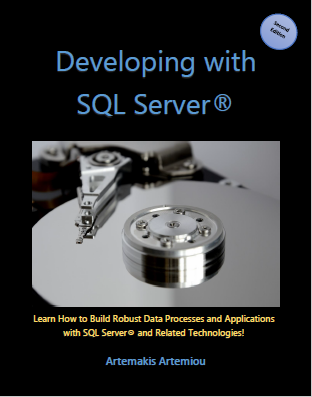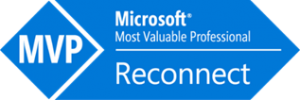If you are interested in SQL Programming in SQL Server, then this eBook is a must. The eBook is dedicated to developing with SQL Server and related technologies. It features a large number of articles on different topics, all with useful step-by-step examples. The eBook assumes at least intermediate-level experience with SQL Server development.
eBook Format: PDF
Author: Artemakis Artemiou, B.Sc., M.Sc., MCP, MCTS, MCITP, Former Microsoft Data Platform MVP (2009-2018)
See Inside this Book:
Table of Contents
Sample Chapter
Price: $39.99
Rate this eBook:
About the Author
Artemakis Artemiou is a Senior SQL Server and Software Architect and Author. Artemakis received the prestigious Microsoft Data Platform MVP award for 9 consecutive years (2009-2018). He has over 15 years of experience in the IT industry in various roles. Artemakis is the founder of SQLNetHub and TechHowTos.com. Artemakis is the creator of the well-known software tools Snippets Generator, DBA Security Advisor and In-Memory OLTP Simulator. Moreover, he is the author of many eBooks on SQL Server. Artemakis currently serves as the President of the Cyprus .NET User Group (CDNUG) and the International .NET Association Country Leader for Cyprus (INETA). You can follow Artemakis on Twitter.
Table of Contents
Introduction
Chapter 1: Programming
– Searching for Keywords in SQL Server Jobs
– Sequence Object-Like Functionality in SQL Server
– Sequence Objects in SQL Server
– Retrieving Only the Date from a Datetime Value in SQL Server
– Updating SQL Server Tables Without Causing Blocking
– Using the NOLOCK Table Hint
– Dynamically Generating T-SQL Statements
– Segmenting Strings in SQL Server
– Eliminating Blank Spaces in SQL Server Tables
– New Date-Related Functions in SQL Server 2008
– Commonly Used String Functions in SQL Server
– DATETIME2 vs DATETIME in SQL Server
– The TIME Data Type in SQL Server
– The DATE Data Type in SQL Server
– The MERGE Statement in SQL Server
– Divide by Zero Error Encountered
– String or Binary Data Would be Truncated
– Row Constructors in SQL Server
– Table-Valued Parameters (TVPs) in SQL Server
– How to Establish a Simple Connection from a C# Program to SQL Server
– The STRING_SPLIT Function
– Built-In JSON Support in SQL Server
– Temporal Tables
– Summary
Chapter 2: Working with Unstructured Data
– How to Import and Export Unstructured Data in SQL Server – The IMAGE Datatype
– How to Import and Export Unstructured Data in SQL Server – FILESTREAM
– How to Import and Export Unstructured Data in SQL Server – FileTables
– Summary
Chapter 3: Data Access
– The ADO .NET Entity Framework
– The Entity Framework: Introduction
– The Entity Framework: Inheritance
– Data Access and Consumption with WCF Data Services and PowerPivot
– Summary
Chapter 4: T-SQL Tips
– Listing all Tables of a Linked Server’s Database
– Retrieving Security-Related Info for SQL Server Logins
– Inserting Leading Characters to a String
– Getting all the Records from all Tables in all User Databases
– Retrieving SQL Server Instance-Related Information
– Retrieving Database File Sizes
– Summary
Chapter 5: Special Topics
– Where are Programmability Objects Stored in SQL Server?
– Internal Query Processor Error: The query processor could not produce a query plan
– Executing Heavy Set-Based Operations Against VLDBs in SQL Server
– Using the OUTPUT Clause: A simple Data Archiving Example
– Using Computed Columns in SQL Server
– Where are Temporary Tables Stored in SQL Server?
– Handling NULL and Empty Values in SQL Server
– The multi-part identifier … could not be bound
– Table-Level Locking Hints in SQL Server
– Handling NULL Character \x00 when Exporting to File Using BCP
– The conversion of a char data type to a datetime data type resulted in an out-of-range datetime value
– Error Converting Data Type Varchar to Float
– Undocumented Stored Procedure sp_MSforeachdb
– Using the “GO” Command in SQL Server
– Summary
Chapter 6: Miscellaneous
– Accessing Reporting Services Using a Fully Qualified Domain Name
– Transferring Ownership of All Database Objects Back to DBO
– There is insufficient system memory in resource pool ‘internal’ to run this query
– Mastering the Data World: Extracting Knowledge from a DBMS
– Software Systems in the 21st Century: Integration is the Key
– Changing the Database Owner in a SQL Server Database
– SQL Server 2008 Collation Alignment with Windows Server 2008
– How to Suppress the “N Row(s) Affected” Output Message in SQL Server
– Summary
Appendix A
List of Listings
List of Figures
List of Tables
Who Should Read This Book?
This book is for database developers and architects who develop SQL Server databases and related database processes. The book features tens of articles that provide detailed information on how to develop in SQL Server but also in Visual Studio. However, the book is not intended to be a step-by-step comprehensive guide. Additionally, it assumes at least intermediate-level experience with SQL Server development and knowledge of basic database principles.
How Is This Book Organized?
This book is organized as follows. Chapter 1 discusses different programmability topics on SQL Server as well as ways to handle different problems you might encounter while developing database operations. Chapter 2 discusses how you can work with unstructured data in different versions of SQL Server. Chapter 3 discusses Data Access topics and more specifically the ADO.NET Entity Framework as well as WCF Data Services. Chapter 4 provides some straight to the point T-SQL tips for performing specific tasks. Chapter 5 features several special topics on SQL Server like where programmability objects are stored and how to retrieve information about them. Finally, Chapter 6 discusses miscellaneous topics on SQL Server and on generic database-related topics.
Related eBooks
Recommended Online Course
Essential SQL Server Development Tips for SQL Developers
Sharpen your SQL Server database programming skills via a large set of tips on T-SQL and database development techniques.





